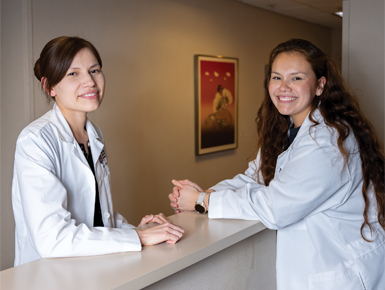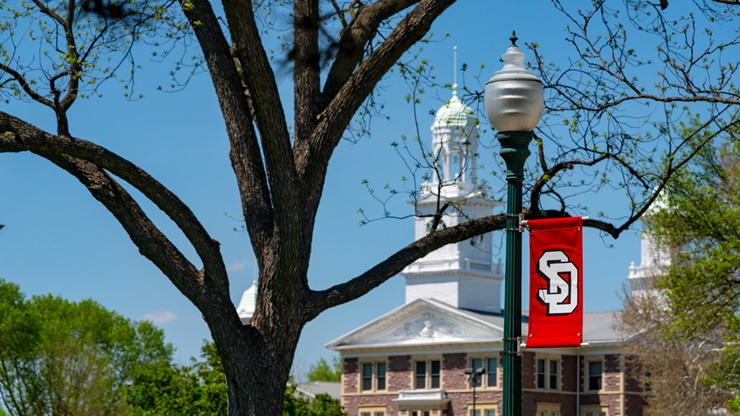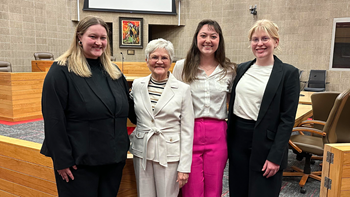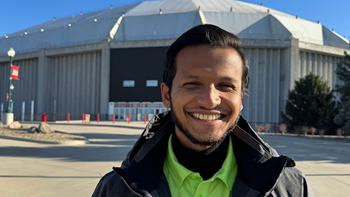First Native American USD Medical School Graduate Sophie Two Hawk Deeply Rooted in Healing

The internist at Avera Medical Group in Sioux Falls was encouraged by high school teachers and counselors to consider becoming a licensed practical nurse (LPN), but she felt a different calling. Sophie’s great-grandmother was a keeper of traditional medicine for the Lakota people; her grandmother was an LPN and although Sophie Two Hawk’s mother yearned to be a physician, she grew up in a time when doing so was very difficult for women – especially for Native women – and so she worked as a medical technologist at several Indian Health Service (IHS) facilities in South Dakota and was the director for the South Dakota Urban Indian Health facility in Sioux Falls.
“We’d go into work with Mom in the lab sometimes when we were kids and really enjoyed that,” Sophie Two Hawk remembers. “Young women didn’t go into medicine then, especially Native women. There wasn’t a huge support system at the time.”
An enrolled member of the Cheyenne River Sioux Tribe, Sophie Two Hawk was born in Winner, South Dakota. She moved many times while growing up, living on and off the reservations before her family relocated to Sioux City, Iowa, where she graduated high school at the age of 16 as class valedictorian. She finished her undergraduate degree in just three years at the University of South Dakota.
Sophie Two Hawk would go on to become the first Native American person to graduate from the USD Sanford School of Medicine (SSOM), in 1987. Doing so at age 23, she believes she may also be the youngest.
After her Internal Medicine Residency in Sioux Falls and her Critical Care Fellowship at the National Institutes of Health in Bethesda, Maryland, she became an active-duty officer in the U.S. Public Health Service, serving at several IHS hospitals in South Dakota as a physician, clinical director and chief executive officer.
With her career in the IHS, U.S. Public Health Service and as medical director with the TRICARE Overseas Program, the Two Hawk family moved all over the country, including Maryland, Colorado, New Mexico, California, Iowa and South Dakota, but they always relocated as a family unit. Sophie Two Hawks’s husband, Albert Two Hawk, stayed home during the day with their three daughters and raised horses. Albert Two Hawk is a spiritual leader for his people, and the couple has always spent time working together to help patients and educating health care providers about American Indian culture and beliefs, which they continue to do today.
Sophie Two Hawk’s career has been marked by recognitions including the National Indian Health Service Director’s Award, leadership awards, and the U.S. PHS Superior Service Award and Achievement Medal. Retirement from active-duty military public health service after a long career didn’t last very long, as she came out of retirement after a few short months in 2019 to return to practice at Avera.
Sophie Two Hawk has been a strong role model to many, but especially to her three daughters, two of whom, Dr. Arna Mora and Dr. Carol Whitman, are currently in medical residencies. Her third daughter, Mashke Two Hawk, is a pre-med student currently in her undergraduate years at USD.
Whitman is a 2020 SSOM graduate currently in her fourth year of a psychiatry residency program at the USD SSOM. Born in Rosebud, South Dakota, she grew up going to work with her mother on occasion, spending time in her office or talking to staff members. “I liked watching how Mom worked on a team,” Carol says. She graduated as valedictorian at Todd County High School at just 15 years old and was scarcely 16 when she entered college at the University of North Dakota (UND).
Mora is a 2021 alumna of the UND School of Medicine and Health Sciences and is now in her final year of residency at the Center for Family Medicine in Sioux Falls, where she has interests in diabetes management and women’s health. Mora, like her mother and sister, also graduated high school from Cheyenne-Eagle Butte at a young age, at 17.

“I remember always being impressed by Mom, seeing all she went through,” Mora says. “I have always looked up to her.”
“For the family, patient care is not just the physical condition of the patient, it’s whole-person healing, all parts of patient care, for all those who are touched by that patient,” Sophie explains. “As Native people we view health as Wicozani, a holistic overview to health care.”
Sophie Two Hawk and her two physician daughters recently participated in the “Prairie Doc” show on South Dakota Public Television. Part of their message was submitted as an article in the April 20, 2023, “Summerland Advocate-Messenger,” part of which states:
“American Indians face unique challenges when it comes to caring for their health. Culturally, we view health in a holistic manner as a balance of our bodies, minds and spirits that allows for good health. Historically, women would have knowledge of herbs and men would be spiritual healers.”
When the IHS was formed in 1955 to oversee Indian health care for the country, it did so amidst a history of mistrust and discrimination. Native Americans weren’t considered U.S. citizens until 1924 and not all states allowed them to vote until decades later.
That context has informed Sophie Two Hawks’ work. She has made deliberate efforts to help Native people overcome the loss of trust in physicians throughout her medical education and as her career progressed. She took it upon herself to educate those around her, giving lectures and publishing articles; anything she could to get as much exposure as possible and educate colleagues at every opportunity. She still brings those efforts to her patient care. “I see it as a responsibility to bring that approach to all health care,” she shares. “Things are moving in the right direction.”
The two sisters found an important support system with the Indians Into Medicine (INMED) program, which they say solidified their desire for medical careers. INMED recruits American Indian middle school and high school students from South Dakota and Nebraska to participate in the INMED Summer Institute, a six-week program held each July to encourage American Indians to participate in health care careers.
Both women attended the health career camp every year from grades 7-12. Mora clicked with INMED staff during her time there and later taught biology classes for the program. “INMED has been a really big source of support and has given me the confidence to pursue something as difficult as a medical career,” Mora says.
If strong family roots and learning by example have any influence, Native American patient advocacy will continue among further generations of the Two Hawk family, as it has for decades.
“I enjoy being the person able to build trust back for people who have lost trust in the medical system,” says Mora. “I’m grateful for the opportunity to go to med school in the first place, and it’s encouraging that being a woman and a minority, I can be a part of patient lives in a way that benefits them more than I thought I could.”
Mora looks forward to caring for patients all along their lifetimes at Pipestone County Medical Center and Family Clinic Avera. “Helping to manage chronic conditions like diabetes and watching them progress is rewarding and creates a balance in my own life,” she says. “I’d like to be remembered as someone who did what I could with each patient and family.”
As she continues her career in psychiatry at Avera, Whitman says, “I like helping people get through very tough times. Being in someone’s corner and helping them through is rewarding.”
The women currently maintain their involvement with the medical school, as all three sit on the SSOM Native American Advisory Cabinet and are clinical professors. Sophie Two Hawk credits former SSOM Deans Robert Talley and Rod Parry for bringing Native American efforts to the forefront of the medical school’s priorities.
“We are starting to see more Native Americans become physicians,” she says. “There is much more support now. Faculty members are very interested in learning about the spiritual side of Native health, they are present and integrating this into their practices.”
Now that Sophie’s entire family, including her seven grandchildren, resides in Sioux Falls, the trio of physicians wants to focus on being a solution for culturally competent Native health care in the region. “Coming from reservations where there is a huge need for mental health care, and providing care for many Native families, hopefully I can be part of a solution for that,” says Whitman.
Sophie Two Hawk agrees, saying, “I want people to know I did the best I could as their advocate and in taking care of their whole person.”



